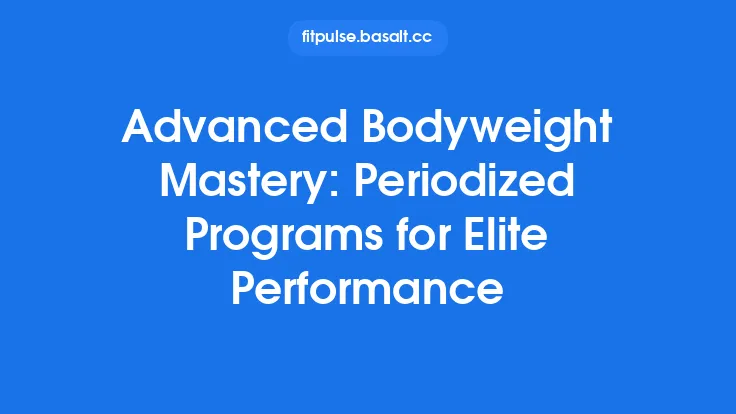Elite athletes constantly search for marginal gains, and the fine‑tuning of flexibility and mobility is no exception. While most practitioners are comfortable with the basic dynamic warm‑up, the next performance plateau often requires a deeper, more sophisticated approach to dynamic stretching. Below is a comprehensive guide to advanced dynamic stretching techniques that can be woven into the training ecosystem of high‑level competitors. The emphasis is on evidence‑based methods, precise loading principles, and systematic programming that respect the unique demands of elite sport.
Loading Principles for Dynamic Stretching
Dynamic stretching is traditionally viewed as a low‑load, movement‑centric activity. In the elite context, however, the addition of external or internal load can amplify the stretch‑shortening cycle (SSC) and stimulate greater neuromuscular adaptations.
| Load Type | Typical Modality | Primary Adaptation | Example |
|---|---|---|---|
| External Resistance | Weighted vests, dumbbells, kettlebells, resistance bands | ↑ Muscular tension during motion, enhanced proprioceptive feedback | Walking lunges with 10 kg dumbbells |
| Inertial Load | Medicine balls, weighted sleds | ↑ Force‑velocity demands, improved SSC efficiency | Overhead medicine‑ball throws combined with torso rotation |
| Plyometric Load | Jumping, bounding, depth jumps | ↑ Explosive power, rapid stretch‑reflex activation | High‑knee skips with a 2 kg ankle weight |
| Isometric Pre‑Activation | Brief holds at end‑range before dynamic movement | ↑ motor unit recruitment, heightened stretch tolerance | 3‑second wall sit before dynamic squat jumps |
Key Guidelines
- Progressive Overload – Begin with body‑weight dynamics, then incrementally add load (≈5‑10 % of the athlete’s one‑rep max for the target muscle group) while monitoring technique.
- Load‑Specific Velocity – Heavier loads should be moved at moderate speeds (0.5–0.75 m·s⁻¹) to preserve joint integrity; lighter loads can be executed explosively (>1.5 m·s⁻¹) to target the SSC.
- Load Distribution – Use bilateral loads for symmetrical development and unilateral loads to address asymmetries identified in sport‑specific assessments.
Plyometric and Ballistic Dynamic Stretching
Plyometric dynamic stretches blend the traditional range‑of‑motion (ROM) component with rapid, elastic energy utilization. This hybrid approach is especially valuable for sports that demand high‑velocity limb acceleration (e.g., sprinting, basketball, volleyball).
Core Concepts
- Stretch‑Shortening Cycle (SSC) Amplification – By intentionally over‑stretching a muscle‑tendon unit (MTU) before a rapid concentric action, the athlete leverages stored elastic energy.
- Neuromuscular Priming – The rapid transition from eccentric to concentric phases heightens gamma‑motor neuron activity, improving muscle spindle sensitivity.
Representative Protocols
- Bounding with Over‑Stride – Athletes perform exaggerated forward bounds, deliberately over‑extending the hip and knee on the landing leg before an immediate rebound. 3 sets of 8 bounds per leg, 30 s rest.
- Depth‑Jump Dynamic Lunge – From a 30 cm box, step down into a lunge, allowing a brief eccentric dip (≈0.2 s) before explosively driving the front leg upward. 4 × 6 reps per leg.
- Rotational Medicine‑Ball Throws – From a standing split stance, rotate the torso while swinging a 3 kg medicine ball across the body, releasing at maximal angular velocity. 3 × 10 throws per side.
Implementation Tips
- Keep ground contact times ≤ 0.15 s to maximize SSC utilization.
- Prioritize quality of movement over volume; early fatigue can compromise joint alignment.
- Integrate these drills after a general dynamic warm‑up but before heavy resistance work.
Integrating Resistance Bands and Weighted Implements
Elastic bands and weighted implements provide variable resistance that can be tuned to the athlete’s strength curve, offering a nuanced stimulus that static loads cannot replicate.
Band‑Assisted Dynamic Stretching
- Band‑Assisted Leg Swings – Anchor a light‑to‑moderate band (≈15–30 % of body weight) to a stable point; the athlete performs forward‑backward or lateral leg swings, allowing the band to assist at the start of the motion and resist at the end‑range. This creates a “reverse‑eccentric” load that encourages greater hip flexion/extension ROM.
- Band‑Resisted Arm Circles – With a band anchored behind the back, the athlete performs large‑amplitude arm circles, increasing shoulder external rotation ROM while simultaneously loading the rotator cuff.
Weighted Implement Dynamics
- Weighted Hip Circles – Holding a 5 kg kettlebell at chest level, the athlete performs controlled hip circles (10 ° increments) to improve lumbar‑pelvic mobility under load.
- Ankle‑Weighted High‑Knee Drills – Secure 1–2 kg ankle weights and execute high‑knee runs, emphasizing rapid hip flexion while the added mass challenges the hip flexors and quadriceps.
Programming Considerations
- Band Tension Gradient – Use bands that increase tension progressively throughout the ROM to match the muscle’s force‑length relationship.
- Load Cycling – Alternate weeks of band‑only work with weeks of weighted implement work to avoid over‑reliance on a single stimulus.
- Safety Checks – Ensure bands are inspected for wear and that weighted implements are securely fastened to prevent slippage.
Periodization and Load Management
Advanced dynamic stretching should be embedded within the broader periodization framework of the athlete’s training plan. This ensures that flexibility work complements strength, power, and skill development without causing interference.
| Phase | Primary Goal | Dynamic Stretching Focus | Volume & Intensity |
|---|---|---|---|
| Preparatory (General) | Build baseline mobility | Low‑load, high‑repetition band drills | 3 × 15‑20 reps, 2 × /week |
| Preparatory (Specific) | Translate mobility to sport patterns | Loaded plyometric stretches, sport‑specific angles | 4 × 8‑12 reps, 3 × /week |
| Pre‑Competition | Optimize neuromuscular readiness | High‑velocity ballistic stretches, minimal load | 2 × 6‑8 reps, 1‑2 × /week |
| Competition | Maintain ROM, prevent stiffness | Light‑load dynamic maintenance, quick activation | 1 × 4‑6 reps, as needed |
| Transition/Recovery | Facilitate tissue turnover | Low‑intensity band‑assisted flows, active recovery | 2 × 10‑15 min sessions, 2 × /week |
Load Management Strategies
- Acute‑Chronic Workload Ratio (ACWR) – Track the cumulative load of dynamic stretching (e.g., total band tension × reps) and keep the ratio below 1.0 to minimize overuse risk.
- Fatigue Monitoring – Use subjective wellness questionnaires and objective markers (e.g., HRV) to adjust stretch intensity on high‑stress days.
- Deload Weeks – Reduce load by 30‑50 % during planned deloads, focusing on mobility flow rather than strength‑oriented dynamic stretches.
Neuromechanical Considerations
Understanding the underlying neuromechanical mechanisms helps coaches prescribe the most effective advanced techniques.
- Muscle Spindle Sensitivity – Rapid dynamic stretches increase Ia afferent firing, priming the stretch‑reflex for subsequent explosive actions. Loading the MTU during the stretch phase further heightens spindle responsiveness.
- Golgi Tendon Organ (GTO) Modulation – Controlled eccentric loading (e.g., slow‑tempo band‑assisted swings) can desensitize GTO inhibition, allowing higher force output during concentric phases.
- Tendon Stiffness Adaptation – Repeated high‑velocity dynamic stretches under load promote collagen remodeling, increasing tendon stiffness and improving force transmission.
- Motor Unit Recruitment Patterns – Plyometric dynamic stretches recruit high‑threshold motor units early, facilitating better inter‑muscular coordination for sport‑specific tasks.
Practical Takeaway: Pair high‑velocity dynamic stretches with brief isometric holds at end‑range to simultaneously stimulate spindle activity and GTO adaptation, creating a balanced neuromechanical environment.
Assessment and Monitoring
Advanced dynamic stretching programs should be data‑driven. The following assessment tools enable precise tracking of progress and identification of asymmetries.
- 3‑D Motion Capture – Quantify joint angles, angular velocities, and segmental timing during dynamic stretch drills. Look for > 5 % inter‑limb differences as a red flag.
- Surface EMG – Measure muscle activation patterns during loaded dynamic stretches. An increase in peak EMG amplitude (> 10 % over baseline) indicates successful neuromuscular priming.
- Myotonometry – Assess muscle tone and stiffness pre‑ and post‑stretching sessions. A reduction in passive stiffness of 5‑8 % after a loading phase suggests effective elasticity enhancement.
- Force Plate Analysis – Capture ground reaction forces during plyometric dynamic stretches. Improvements in peak force and reduced contact time reflect better SSC utilization.
Monitoring Frequency
- Baseline assessment at the start of each macrocycle.
- Mid‑phase reassessment (every 4–6 weeks) to adjust load.
- Post‑competition debrief to evaluate maintenance efficacy.
Programming Strategies for Elite Athletes
Below is a sample weekly microcycle for a sprinter in the pre‑competition phase, illustrating how advanced dynamic stretching can be integrated without compromising other training components.
| Day | Session Focus | Advanced Dynamic Stretch Component |
|---|---|---|
| Mon | Heavy Squat + Plyometrics | Weighted Walking Lunges (3 × 10 m, 12 kg) → Depth‑Jump Dynamic Lunge (4 × 6) |
| Tue | Technical Sprint Drills | Band‑Assisted High‑Knee Drills (2 × 30 m, 20 % body weight) → Rotational Medicine‑Ball Throws (3 × 8) |
| Wed | Recovery / Mobility | Light Band‑Assisted Hip Circles (2 × 15 reps) → Foam‑Roll Flow (10 min) |
| Thu | Power Clean + Speed Work | Weighted Hip Circles (3 × 12, 5 kg) → Bounding with Over‑Stride (3 × 8 per leg) |
| Fri | Competition Simulation | Ballistic Arm Swings with Light Band (2 × 20) → Quick‑Change Leg Swings (no load, 2 × 15) |
| Sat | Rest | — |
| Sun | Light Conditioning | Dynamic Mobility Flow (band‑assisted, 15 min) |
Key Points
- Load intensity is matched to the primary training stimulus of the day (e.g., heavier loads on strength days, lighter, high‑velocity work on speed days).
- Volume is kept modest (≤ 4 sets per drill) to avoid cumulative fatigue.
- Recovery sessions incorporate low‑intensity dynamic movements to maintain ROM without adding stress.
Case Studies and Practical Applications
Case Study 1: Elite Female Swimmer – Enhancing Shoulder Internal Rotation
Challenge: Limited internal rotation ROM contributed to decreased stroke length and shoulder impingement symptoms.
Intervention: Over a 6‑week block, the athlete performed band‑assisted internal rotation swings (30 % of maximal band tension) combined with weighted overhead medicine‑ball throws (2 kg) three times per week.
Outcome: Internal rotation ROM increased by 12 °, peak shoulder torque during pull‑phase improved by 8 %, and reported shoulder discomfort decreased by 70 % (measured via VAS).
Case Study 2: Professional Soccer Midfielder – Optimizing Hip Flexor Power
Challenge: Sub‑optimal hip flexor activation during high‑speed sprints, leading to reduced acceleration.
Intervention: Implemented ankle‑weighted high‑knee drills (1.5 kg per ankle) and plyometric dynamic lunges with a 10 kg vest, performed twice weekly for 8 weeks.
Outcome: 5‑m sprint time improved by 0.07 s, hip flexor EMG peak amplitude increased by 15 % during sprint start, and the athlete reported a heightened sense of “explosiveness” in the first 10 m.
Practical Takeaway
Both cases illustrate that targeted loading of dynamic stretches can produce measurable improvements in sport‑specific performance metrics while simultaneously addressing injury‑related limitations.
Safety, Recovery, and Contraindications
Even at the elite level, advanced dynamic stretching carries inherent risks if misapplied.
- Joint Integrity: Avoid excessive end‑range loading on joints with known laxity (e.g., hypermobile shoulders). Use a limited ROM or substitute with band‑assisted low‑tension variations.
- Acute Fatigue: Perform high‑intensity ballistic stretches only when the athlete is fully rested; fatigue can impair motor control and increase injury risk.
- Tissue Health: For athletes with recent tendinopathy, prioritize low‑load, high‑velocity movements that promote tendon remodeling without excessive strain.
- Recovery Integration: Pair intense dynamic stretching sessions with active recovery modalities (e.g., contrast baths, compression) to facilitate metabolic clearance.
A simple “pre‑stretch checklist” can be employed before each session:
- Pain Check: No sharp or lingering pain during the previous 24 h.
- Mobility Baseline: Verify that ROM is within 5 % of baseline measurements.
- Load Confirmation: Ensure prescribed load matches the day’s training intensity.
- Technique Review: Confirm that movement patterns are clean and controlled.
Future Directions and Research Frontiers
The field of advanced dynamic stretching is evolving, with several promising avenues:
- Wearable Sensor Integration: Real‑time feedback on angular velocity and joint loading can enable on‑the‑fly adjustments, ensuring optimal stimulus.
- Neuromodulation Synergy: Combining transcranial direct current stimulation (tDCS) with dynamic stretching may further enhance motor cortex excitability, potentially accelerating adaptation.
- Individualized Load‑Response Modeling: Machine‑learning algorithms that predict an athlete’s optimal stretch load based on historical EMG and performance data are under development.
- Hybrid Training Protocols: Merging dynamic stretching with blood‑flow restriction (BFR) training could amplify hypertrophic and connective‑tissue responses while maintaining mobility gains.
Continued interdisciplinary research—spanning biomechanics, neurophysiology, and sports medicine—will refine these techniques and solidify their place in elite performance programming.
Bottom Line: Advanced dynamic stretching is far more than a warm‑up accessory; it is a potent, load‑driven stimulus that can enhance ROM, neuromuscular activation, and sport‑specific power when applied strategically. By integrating progressive loading, plyometric dynamics, precise periodization, and rigorous monitoring, elite athletes can unlock new levels of performance while safeguarding against injury. The tools and protocols outlined above provide a robust framework for coaches, physiotherapists, and athletes seeking to elevate their mobility work from functional to truly transformational.





